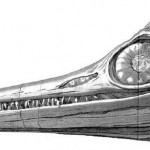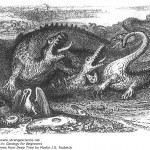 If you’d lived in the early 19th century, what would you have thought if you came across a perfect ammonite fossil washed up on the shore? I was fascinated by the European folk explanations for fossils and by the science of the era just before Darwin, especially the intellectual contortions academics like William Buckland went through to try to reconcile fossil finds with the creation myth in Genesis. Some of Buckland’s arguments still pop up in the books and websites of creationists and proponents of “intelligent design.” And beyond that, I was deeply drawn to a period where individuals were confronted with the need to revise their view of nature and man’s place in it, as we are desperately in need of doing today.
If you’d lived in the early 19th century, what would you have thought if you came across a perfect ammonite fossil washed up on the shore? I was fascinated by the European folk explanations for fossils and by the science of the era just before Darwin, especially the intellectual contortions academics like William Buckland went through to try to reconcile fossil finds with the creation myth in Genesis. Some of Buckland’s arguments still pop up in the books and websites of creationists and proponents of “intelligent design.” And beyond that, I was deeply drawn to a period where individuals were confronted with the need to revise their view of nature and man’s place in it, as we are desperately in need of doing today.
If you’re interested in the interpretation of fossils through European history, someone to check out is the Swiss naturalist Conrad Gesner (1516-1565). His work does not seem to have influenced the early English fossilists, but it’s strange and wonderful, as was his life. I think there’s a novel there (for some other writer!).
Treasures in the Rare Books room at the British Library
Organic Remains of a Former World by James Parkinson, 1804. A hugely influential text for the natural historians portrayed in Curiosity. Gideon Mantell described it as “the first attempt to give a familiar and scientific account of fossils.” The notion that the “days” of creation might have referred to thousands of years was first expressed by Parkinson.
Vestiges of the Natural History of Creation, 1844 by Robert Chambers. Chambers dared to suggest that the universe was not the result of a single creative act, but developed naturally according to predictable principles.
The Book of the Great Sea-Dragons by Thomas Hawkins, 1840 is riveting for what it reveals about the mishmash of theology, fairy tale, and lurid apocalyptic imaginings that passed for science in some quarters during the period. Thomas Hawkins was a prominent collector who worked with Mary Anning in the 1830’s, and whose collection was bought by the British Museum (although his specimens were discovered to rely rather too heavily on plaster reconstruction). Here’s a taste of Hawkin’s prose:
“We shudder over the old Spectral World, when, armed with poison, fang, and fury, 10,000 hideous monsters slipped from leash, shriek to the four Winds, and scared peace forever away. The Malefactor Adamites gigantic in the Fall, so were the grim Brutes which battled them for blood. They both perish together in the wild exultant Flood. . . . These Sea dragons—by what wondrous application of ribbed joints they  compressed air into the lung, by which to sustain themselves a long while when driven to the nether depths. With what a cunning machinery of eye they trapped and made use of God’s blessed light. We may trace the channels of poison which distilled from their livid gums, the cranial Caverns in which their brutal appetites lurked . . . Our Race was well nigh extinguished and the primal Carnivora destroyed quite; Behold the wrecks of a Deluge strown innumerable everywhere.”
compressed air into the lung, by which to sustain themselves a long while when driven to the nether depths. With what a cunning machinery of eye they trapped and made use of God’s blessed light. We may trace the channels of poison which distilled from their livid gums, the cranial Caverns in which their brutal appetites lurked . . . Our Race was well nigh extinguished and the primal Carnivora destroyed quite; Behold the wrecks of a Deluge strown innumerable everywhere.”
In that vein . . . I just came across a wonderful website on dinosaurs and dragons and the conflation of the two in previous centuries. http://www.strangescience.net/stdino2.htm
Available anywhere
Two books by Martin J. S. Rudwick, both from the University of Chicago Press, are essential texts regarding early paleontology: The Meaning of Fossils: Episodes in the History of Paleontology (1985) and Scenes from Deep Time: Early Pictorial Representations of the Prehistoric World (1992).
The Death of Adam: Essays on Modern Thought by Marilynne Robinson (Picador, 2005). Marilynne Robinson’s essay on Darwinism pushed my thinking about the ways in which we’ve surrendered the concept of evolution to the social Darwinists. Evolution is somehow regarded as free of values; it elevates the cockroach, for its mindless survival, above more complex forms of life. Does this devaluing of life necessarily follow from the collapse of creation myths as literal accounts? As Robinson puts it, “It is as if we no longer sat on chairs after we learned that furniture was only space and atoms.” One of the things that shaped Curiosity was my sense that evolutionary science locates meaning and mystery within the processes of the natural world, rather than draining the natural world of meaning.